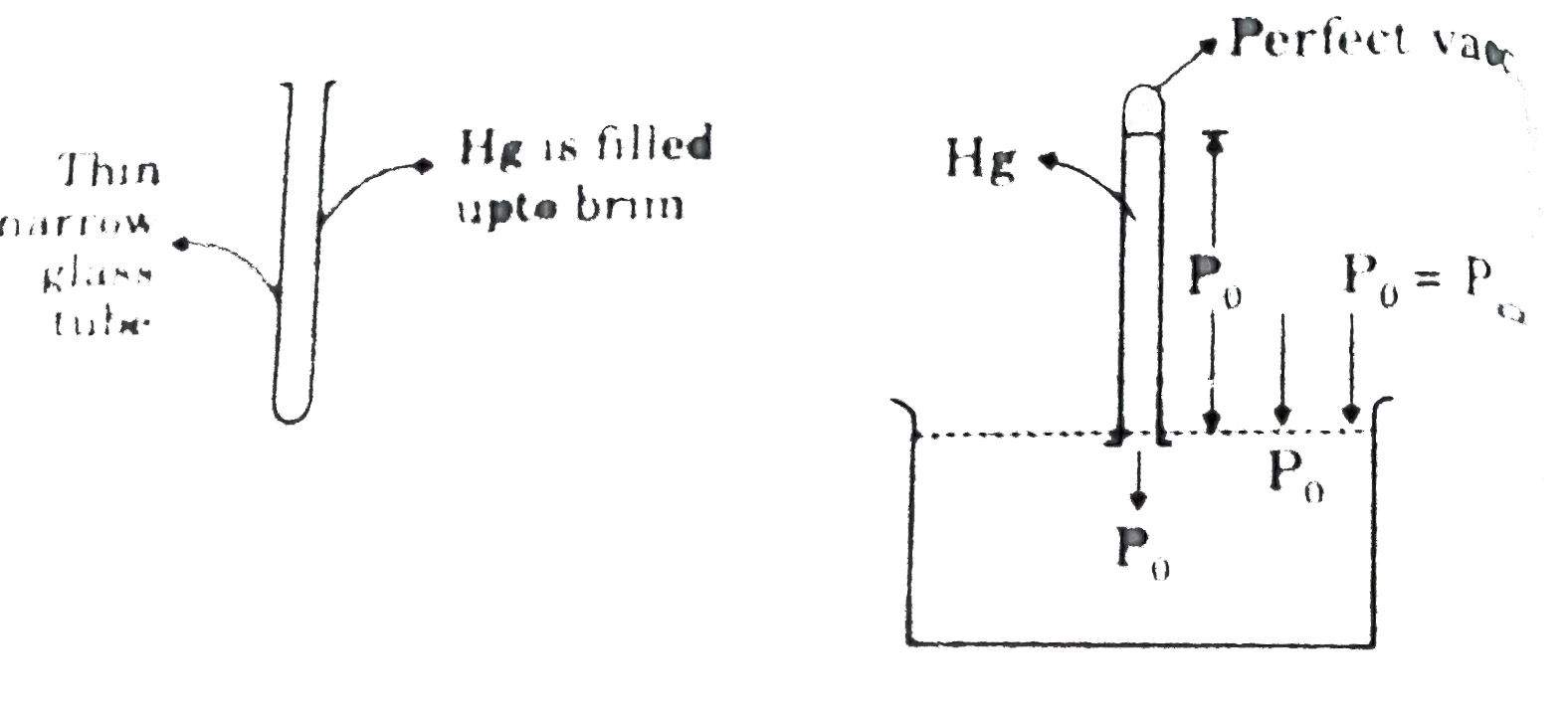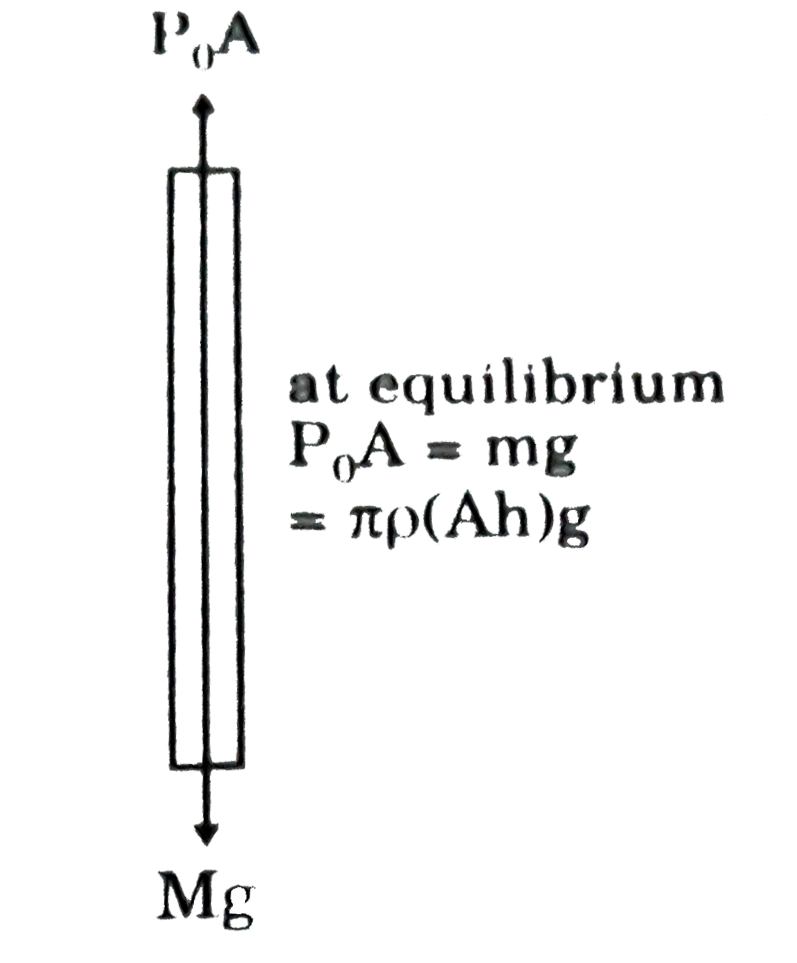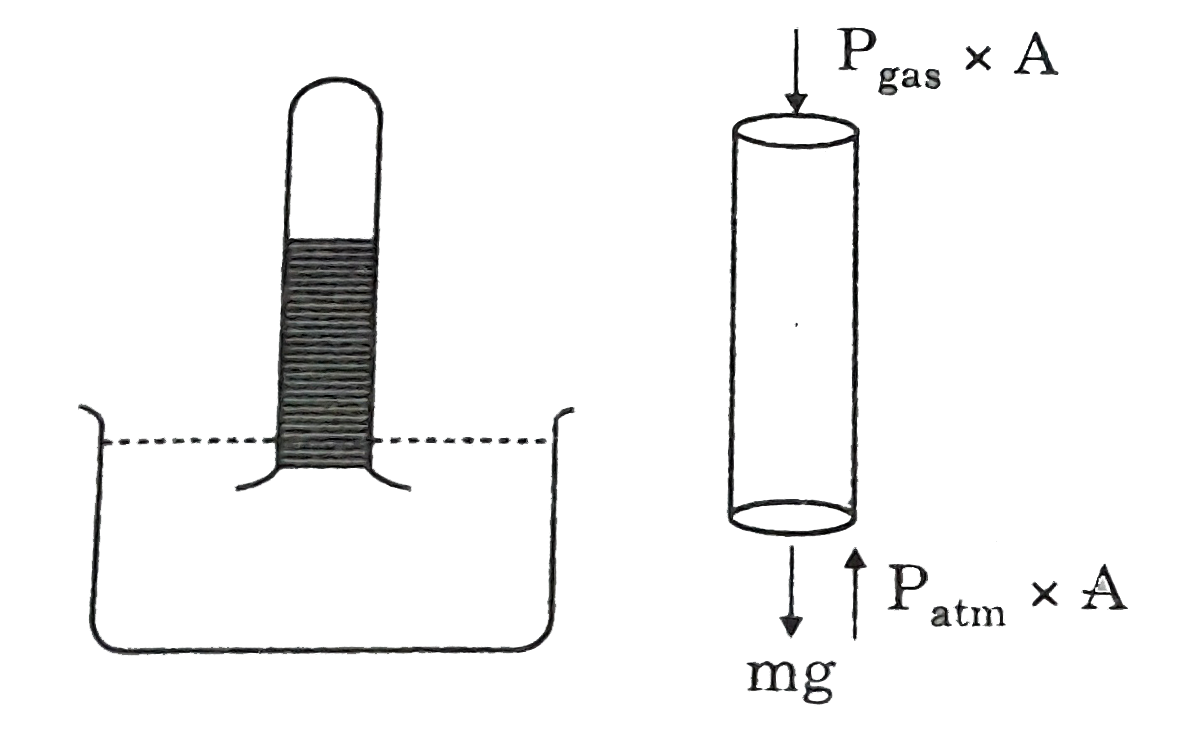A barometer is an instrument that is used for the measurement of pressure The construction of the barometer is as follows:

A thin narrow calibrated capillary tube is filled to the brim with a liquid such as mercury and is inverted into a through filled with the same fluid Now depending on the external atmospheric pressure the level of the inside capillary comes to rest, then the net forces on the column should be balanced Applying force balance we get Patm×A=m×g
(A is the cross-sectional area of the capillary tube) if ρ is the density of the fluid, then m=ρ×g×h
(h is the height to which mercury has risen in the capillary)
Hence Patm×A=(ρ×g×h)×AorPatm=ρgh
Faulty Barometer:
An ideal barometer will show a correct reading only if the space above the mercury column is vacuum but in case if some gas column is trapped in the space above the mercury column then the barometer is classified as a faulty barometer. The reading of such a barometer will be less than the true pressure
For such a faulty barometer
P0A=mg+PgasA
P0=ρhg+Pgas
or ρgh=P0−Pgas
If the tube shown below is placed vertically with the open and upward then the length of the air column will be (Assume temperature remains constant)



20 cm
36 cm
18 cm
15 cm
The correct Answer is:c
Step by step video, text & image solution for A barometer is an instrument that is used for the measurement of pressure The construction of the barometer is as follows: A thin narrow calibrated capillary tube is filled to the brim with a liquid such as mercury and is inverted into a through filled with the same fluid Now depending on the external atmospheric pressure the level of the inside capillary comes to rest, then the net forces on the column should be balanced Applying force balance we get P_(atm)xxA=mxxg (A is the cross-sectional area of the capillary tube) if rho is the density of the fluid, then m=rhoxxgxxh (h is the height to which mercury has risen in the capillary) Hence P_(atm)xxA=(rhoxxgxxh)xxA or P_(atm)=rhogh Faulty Barometer: An ideal barometer will show a correct reading only if the space above the mercury column is vacuum but in case if some gas column is trapped in the space above the mercury column then the barometer is classified as a faulty barometer. The reading of such a barometer will be less than the true pressure For such a faulty barometer P_(0)A=mg+P_(gas)A P_(0)=rhohg+P_(gas) or rhogh=P_(0)-P_(gas) If the tube shown below is placed vertically with the open and upward then the length of the air column will be (Assume temperature remains constant) by Chemistry experts to help you in doubts & scoring excellent marks in Class 11 exams.
Updated on:21/07/2023Topper's Solved these Questions
Similar Questions
For the reaction CO(g)+H2O(g)⇔CO2(g)+H2(g) at a given temperature the equilibrium amount of CO2(g) can be increased by :
View SolutionTotal nubler of mono chlorodervatives obrained by replacement of H by Cl in propene are :
View SolutionTo construct a barometer, a tube of length 1m is filled completely with mercury and is inverted in a mercury cup. The barometer reading on a particular day is 76 cm. Suppose a 1m tube is filled with mercury up to 76 cm and then closed by a cork. It is inverted in a mercury cup and the cork is removed. It is inverted in a mercury column in the tube over the surface in the cup will be
View SolutionMeasuring Pressure By Mercury Barometer
View SolutionIt is difficult to fill a capillary tube with mercury that with water since
View SolutionA barometer is an instrument that is used for the measurement of pressure The construction of the barometer is as follows: A thin narrow calibrated capillary tube is filled to the brim with a liquid such as mercury and is inverted into a through filled with the same fluid Now depending on the external atmospheric pressure the level of the inside capillary comes to rest, then the net forces on the column should be balanced Applying force balance we get P_(atm)xxA=mxxg (A is the cross-sectional area of the capillary tube) if rho is the density of the fluid, then m=rhoxxgxxh (h is the height to which mercury has risen in the capillary) Hence P_(atm)xxA=(rhoxxgxxh)xxA or P_(atm)=rhogh Faulty Barometer: An ideal barometer will show a correct reading only if the space above the mercury column is vacuum but in case if some gas column is trapped in the space above the mercury column then the barometer is classified as a faulty barometer. The reading of such a barometer will be less than the true pressure For such a faulty barometer P_(0)A=mg+P_(gas)A P_(0)=rhohg+P_(gas) or rhogh=P_(0)-P_(gas) A tube closed at one end is dipped in mercury as shown in figure such that the closed surface coincides with the mercury level in the container By how much length of the tube should be extended such that the level of Hg in the tube is 5 cm below the mercury level inside the container? (Assume temperature remains constant)
View Solution[ 3.A liquid of density 1.70g/ml is filled in the barometer,in place of mercury.What should be the length of liquid column,if another barometer filled with mercury,is measuring 75cm pressure? [ (a) 75cm, (b) 600cm (c) 9.375cm, (d) 6000cm]]
View SolutionA simple barometer tube contains some air in it. The length of the tube above the mercury level in the trough is 80 cm. The height of mercury in the tube is 71 cm at normal atmospheric pressure. What is the actual decrease in the atmospheric pressure if the barometer reads 65 cm ?
View SolutionAt normal atmospheric pressure the height of the mercury column in barometer is
View SolutionWhy mercury is used in barometer for measuring atmospheric pressure?
View SolutionBarometer is constructed using liquid . What would be height of liquid column when mercury barometer reads 76cm
View SolutionDescribe mercury barometer for measurement of atmospheric pressure.
OR Describe Torricelli experiment for measurement of atmospheric pressure.
View SolutionName the instrument which is used to measure liquid pressure? Barometer square Thermometer square Conical Flask square Scale square
View SolutionTemperature and Pressure || Barometer Atmospheric Pressure
View SolutionExplain how is the height of mercury column in the tube of a simple barometer, a measure of the atmospheric pressure.
View Solution
